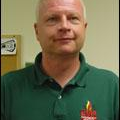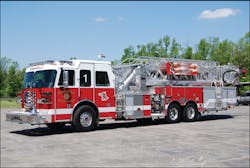Innovative rigs can come in all shapes and sizes and often with very different intended purposes for which they were acquired. In our Innovative Rigs on the Street series so far we have reviewed three pumpers, one CAFS equipped pumper, a tractor drawn aerial ladder and a brush unit designed to operate in the urban interface.
A common thread with each of the previously mentioned units was that the new apparatus was intended to replace an existing, in service rig. Each of the these departments all had the advantage of having an older apparatus from which they were able to leverage their experience to help in the design of the new apparatus.
This month we visit with Bowmansville, NY, where they recently took delivery of their first aerial device when they placed into service a Sutphen SPH-100 midship aerial tower.
The Bowmansville Volunteer Fire Association was formed back in September of 1912 and purchased their first apparatus, a horse drawn hose and chemical wagon with proceeds from a weekend picnic. Like many departments Bowmansville's first motorized rig was a Ford model T which carried chemical tanks, booster hose and several ladders. In later years the department operated a fleet of three pumpers and tankers built on Diamond T chassis with bodywork by Darley. Bowmansville was also a good customer of Young Fire Apparatus over the years and operated a 1975 and twin 1986 Ford C model Young pumpers.
The Department Today
The department annually responds to over 680 runs and is under the command of Chief Tom Trzepacz. The current fleet of apparatus operates from two stations consists of a 1999 and a 2001 Emergency One Cyclone II pumpers each equipped with fully enclosed top-mount pump panels, 1,000-gallon water tanks with Class A foam systems, a 1996 Freightliner-KME heavy rescue with a walk-in body and two Ford F-550 mini rescue units. A 1986 Ford C model Young 1000 gpm pumper is held in reserve service together with the department's antique pumper, a 1928 Buffalo. In addition the department operates two support units and three chiefs vehicles.
The two Bowmansville fire stations serve the western portion of the Town of Lancaster, including a heavily built up commercial area along Transit Road and Genesee Street. Over the years the first due area had developed with more commercial and light industrial properties which influenced the department's planning and apparatus committee's when deciding what type of aerial device would most benefit the community.
After bringing into the district several different types of aerial apparatus as well as visits to manufacturer's facilities the apparatus committee chose a midship mounted aerial tower vehicle. The Bowmansville apparatus committee recognized the advantages of a midship mount tower in the shorter overall length as compared to a rear-mount device and the improved scrub area particularly when operating at strip stores and large area warehouses. After over a year of research the committee set out to work with the Sutphen Corporation in conjunction with local representative Mr. Tim Norris to design their new aerial tower.
The result of this planning was the delivery of a 2010 Sutphen SPH-100 aerial tower that is now assigned as Truck 1. This unit is powered by a Cummins model ISM engine rated at 500-horsepower through an Allison Generation IV model EVS-4000 five-speed automatic transmission. The midship tower design required a front axle rated for 22,000 pounds with a Meritor RT-48-160 rear axle rated at 48,000 pounds. The front axle is equipped with spring suspension with heavy duty shocks with a Raydan air suspension for the rear axle. The apparatus is equipped with Meritor EX-225 17-inch disc brakes on both the front and rear axles with a Jacobs compression engine brake utilized for auxiliary braking.
The Front Of The Rig
The apparatus is built with a wheelbase of 236 inches and an overall length of 47 feet, seven inches. The Sutphen 62-inch cab provides seating for six personnel with five seats equipped with hands-free SCBA brackets and hand tools mounted in PAC brackets for the protection of the crew. Each of the cab seats are provided with a David Clark headset with radio interface capability at the driver, officer and pump panel locations. With the midship tower design the body overhang from the centerline of the rear axle is 194 inches with an angle of departure of 10 degrees. The overall travel height of the apparatus is 11-foot, six inches.
The front bumper was extended 24 inches and is equipped with a 2 1/2-inch front discharge that carries 200 feet of 1 3/4-inch attack line and a short length of 5-inch hose in a full-width tray with a hinged aluminum tread plate cover. The front bumper is reinforced with a 1/4-inch thick by 10-inch high full-width steel plate for protection of the cab and crew. The inside of the four cab doors were finished with stainless steel panels with Whelen 500 series LED amber warning lights provided inside of each door in addition to reflective stripping to alert oncoming vehicles.
The apparatus warning light package consists of a three Whelen roof mounted LED light bars, one 72-inch wide facing forward with two mini LED light bars over the forward cab doors facing the side. Other warning lights consist of Whelen LED lights along the front sides and rear of the apparatus cab and body. Whelen scene lights are provided at the rear of the body to illuminate this area.
The Body
An Onan 15-Kw hydraulic generator provides power for a Hannay cable reel equipped with 150 feet of 10/4 cable and scene lighting. Two Fire Research 1,000-watt Focus lights are mounted on the cab with two telescopic Fire Research Focus 750-watt lights mounted in the platform together with one fixed 750 lamp recess mounted in the front of the platform basket. The rear hose body is finished with white and red chevron stripping together with a combination of red, amber and blue color warning lights. A recessed Safety Vision back up camera is provided together with Britax cornering lights at the rear corners of the body.
The body is fabricated from stainless steel and is provided with 13 enclosed body compartments utilizing a mixture of both painted stainless steel and Robinson roll up shutter doors. The compartments are well designed and laid out using an assortment of slide trays and adjustable shelves with Performance Advantage Company PacTrac and brackets utilized to secure adapters, hand tools and power saw equipment.
Ground ladders are enclosed at the rear of the body and consist of a 35-foot extension, 24-foot extension, 14-foot extension, 16- and 18-foot roof ladders with a 10-foot folding ladder. The ladder compliment is easily identified with a chart showing the ladder length and banking arrangement inside of the compartment door. The rear hose bed is equipped with 800 feet of 5-inch hose which is secured with safety netting across the opening. In addition to the bumper attack line Truck 1 is equipped with two 200-foot 1 3/4-inch attack lines together with a 200 foot 2-inch attack line each in crosslay bed configuration.
Pump and Ladder Specs
The heart of the firefighting package on Truck 1 is provided by a Hale QMax single-stage pump rated at 2,000 gpm which can supply any one of the four attack lines and the four pump panel discharges in addition to the tower waterway. The fire pump intakes consist of two 6-inch inlets each equipped with Hale MIV power operated valves with a 2 1/2-inch auxiliary intake on each side panel. The left side pump panel is provided with two 2 1/2-inch discharges with two 3-inch discharges located at the right side panel that are equipped to supply large diameter hose. A Foam Pro 2002 Class A foam system can supply any one of the four preconnected attack lines with a 30-gallon tank. A 300-gallon water tank is provided to support initial attack operations.
The aluminum huck bolted aerial tower has a vertical reach of 100 feet at an 80 degree elevation with a horizontal reach of 89 feet. The stabilization system consists of two out and down midship mounted outriggers with a 20-foot spread, two rear jacks which operate straight down together with two front suspension locking cylinders which operate automatically when the main outriggers are deployed. The platform is rated for 1,000 pounds in any position with a 500-pound rating when flowing water. The platform basket is equipped with two monitors, one electric remote controlled monitor and one manually operated monitor that is equipped with a stream shaper and smooth bore tips.
The Bowmansville Fire Company's new aerial tower is a good example of a well developed piece of apparatus that took several years to go from the planning stages to the point of accepting delivery of the new unit. I would like to thank Chief Tom Trzepacz and Tim Norris who assisted with technical information on this apparatus.
See Tom Shand Live: Tom will be presenting the following sessions at Firehouse Expo in Baltimore: "Aerial Ladder & Tower Ladder Placement and Operation," "Apparatus Rebuilding: Is this the Answer to Your Replacement Problem?," "Common Problems that Can Lead to Accidents, Overweight Apparatus, and Dangers Therein," and "Preventative Maintenance in Today's Economy." Tom will also be moderating the following session: "Managing Your Fleet Repairs." Tom will join Michael Wilbur as they host the "Apparatus Architects" podcast with a variety of apparatus manufacturers on July 22 at 10:15 a.m. in Room 313.
TOM SHAND is a 37-year veteran of the fire service having served with departments in Maryland, Pennsylvania and New York. He has worked in the fire apparatus industry since 1985, including 15 years with Saulsbury Fire Apparatus. He is a contributing editor to Fire Apparatus Journal and Firehouse Magazine and works with Mike Wilbur at Emergency Vehicle Response. He co-hosts the Apparatus Architects podcast with Wilbur, based on their column in Firehouse Magazine.
About the Author

Tom Shand
TOM SHAND, who is a Firehouse contributing editor, is a 36-year veteran of the fire service. He works with Michael Wilbur at Emergency Vehicle Response, consulting on a variety of fire apparatus and fire department master-planning issues. Shand is a member of the Firehouse Hall of Fame.
